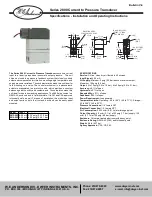
page 60
MARK-V FT-1000MP Operating Manual
U
SING
SUB VFO B
Operation
The Sub VFO works in a similar manner to the Main
VFO, with which you should be familiar by now. The
Sub VFO provides simple split (transmit/receive) fre-
quency operation via the combination of the MAIN
VFO’s RX and TX LED/Buttons and the SUB VFO’s
RX and TX LED Buttons, and, more importantly, dual-
channel reception via the [DUAL] button. We’ll get into
those in a minute, but first let’s look at how to control
the Sub VFO.
Frequency, mode, and Clarifier data can be trans-
ferred from the Main VFO to the Sub VFO by pressing
[A
u
B], but don’t forget that this will overwrite any set-
tings that were in the Sub VFO previously. Also, the
contents of the two VFOs can be swapped (with no
loss of data) by pressing [A
u
B].
Most selections for the Main VFO can also be made
for the Sub VFO directly, by pressing [SUB(CE)] right
before another keypad key to select a band, or before
a mode button to change the Sub VFO mode (displayed
below the Sub VFO frequency). When you press the
[SUB(CE)] key, the entire display for the Sub VFO will
blink, after which you have five seconds to press an-
other key. Note that to switch VFO registers in the Sub
VFO, you need merely press the [SUB(CE)] key fol-
lowed by the key for the same band that the Sub VFO
is already on.
r
To set the Sub VFO (if it currently is on 7.000.0
MHz LSB) to the 14 MHz band,
press [SUB(CE)]
ð
[14(5)].
r
To change to USB, press [SUB(CE)]
ð
[USB].
r
To set the Sub VFO’s frequency to 14.225.00
MHz USB in one step,
press [SUB(CE)]
ð
[ENT]
ð
[1.8(1)]
ð
[10(4)]
ð
[3.5(2)]
ð
[3.5(2)]
ð
[14(5)]
ð
[USB]
ð
[ENT].
Unlike the Main VFO, with its triple-conversion re-
ceiver, the Sub VFO receiver uses double-conversion
circuitry with 47 MHz and 455 kHz intermediate fre-
quencies. Filters are selected automatically in the sub
receiver, according to the operating mode. A 6-kHz AM
filter and 2.4-kHz SSB/CW filter come installed from
the factory. For CW work, a third optional 500-Hz nar-
row filter is also available from your dealer. After instal-
lation, this filter pathway must be enabled via
menu
selection 5-8
. During operation, you can select this filter
by pressing [SUB(CE)]
ð
[NAR1] or [ SUB(CE)]
ð
[NAR2].
Of course, you can tune the Sub VFO using its tun-
ing knob, and use faster tuning steps by holding the
[FAST] button (below the left side of the main tuning
knob). You can use the large DOWN(
q
) and UP(
p
)
keys (in both normal and 1-MHz fast steps) for the Sub
VFO as well, if you just press the [SUB(CE)] key first.
About the only things you cannot do with the Sub
VFO (that you can with the Main VFO), are store it
directly into a memory, and set the Clarifier. For these
functions you need to swap it with the Main VFO first
(push [A
ut
B], then hold the [A
u
B] button for ½-sec-
ond (to store it in a memory) or set the Clarifier, and
then press [A
ut
B] again to return the data to the re-
spective VFOs.
D
UAL
R
ECEPTION
Pressing the blue [DUAL] button activates the SUB
VFO-B receiver. The “DUAL” indicator will appear at
the left of the display, and the green “RX” LED above
the SUB VFO-B tuning knob lights. Instead of press-
ing the blue [DUAL] button, you also can simply press
the green “RX” LED, as this actually is a combined
switch/LED.
Dual receive operation opens up exciting operating
possibilities for split operation, contesting, and chas-
ing elusive DX stations. For split-frequency DX pile-
ups the ability to listen to both “sides” of the pile-up
allows very precise timing of your calls. For contest-
ing, dual receive allows you to continue a “run” on your
“main” frequency while keeping an ear on a DX “multi-
plier” that might not be listening for your call area, for
example.
The Main and Sub VFO share the same antenna
and front-end bandpass filter, and so should be tuned
fairly close to each other for maximum sensitivity (that
is, within 500 kHz or so at low frequencies, or within
several MHz at higher frequencies). Although you may
be able to receive on, say, 21 and 28 MHz at the same
time, you may find the SUB VFO-B receiver signal at-
tenuated.
There are 12 BPF networks in the receiver front-
end circuitry, each covering a particular segment of the
transceiver’s full receive range. SUB VFO-B receiver
specifications are only guaranteed while tuning within
the same bandpass as the MAIN VFO-A.
Main and Sub VFO Audio
The AF GAIN knob controls the Main VFO’s vol-
ume level, and the smaller SUB AF knob controls the
Sub VFO’s volume. The effect these controls have on
receiver audio can be changed, and is configured us-
ing
menu selection 4-9
. AF GAIN control knob opera-
tion can be set to either of the two following modes:
Separate
- The receiver volume for the Main and
Sub VFOs is adjusted independently. This simply
means that the AF GAIN knob controls the MAIN VFO-
A volume and the small SUB AF knob controls the Sub
VFO’s volume.
















































